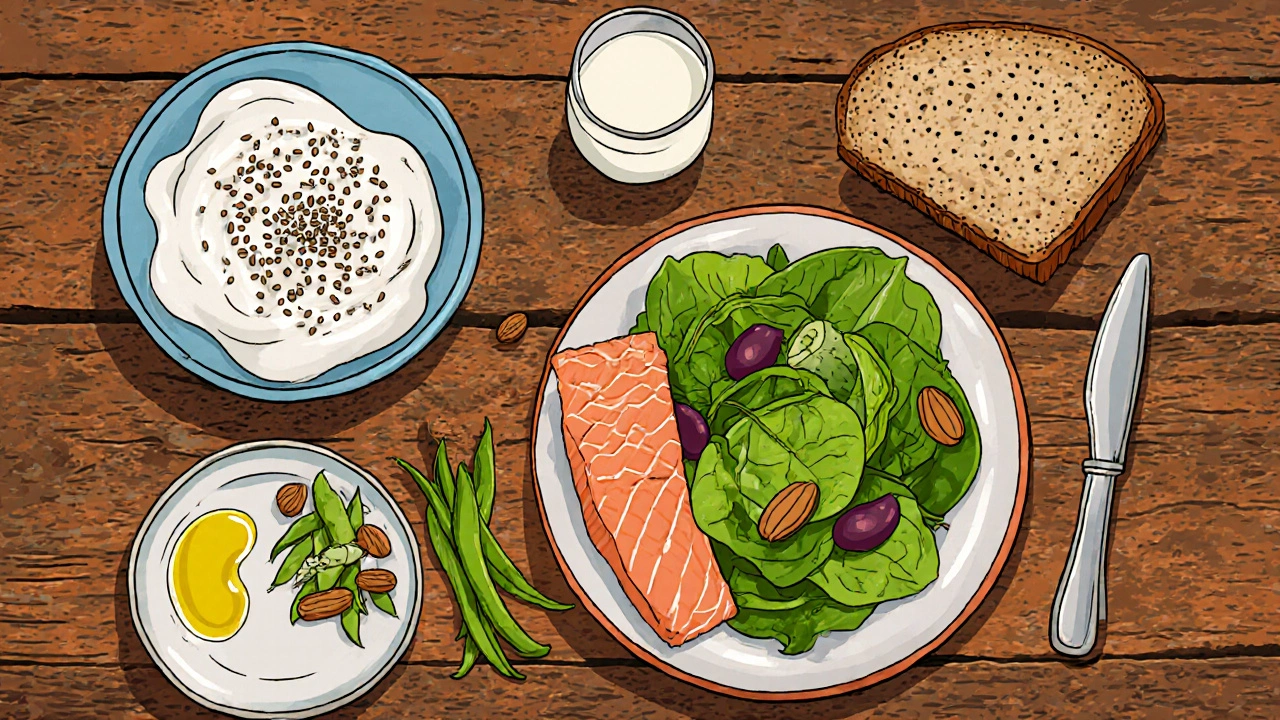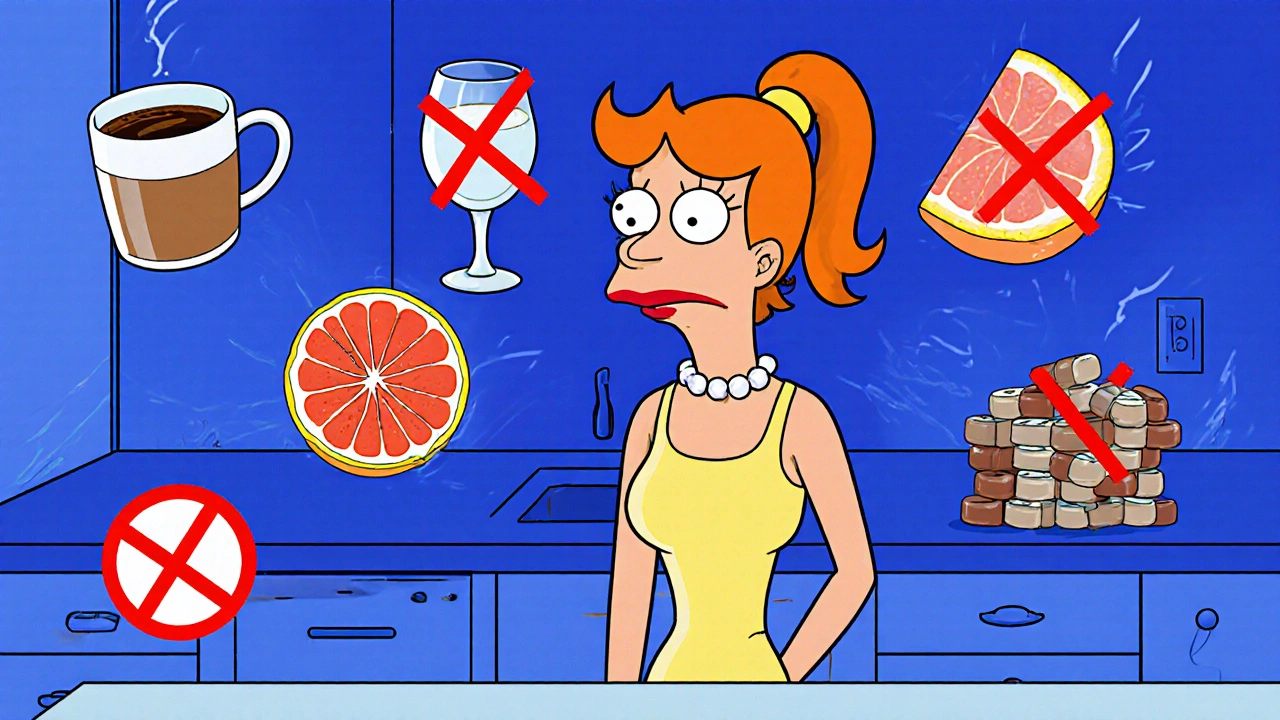Quick Takeaways
- Take tibolone with meals that contain healthy fats to boost absorption.
- Prioritize calcium (1,200 mg) and vitamin D (800‑1,000 IU) to support bone protection.
- Include phytoestrogen‑rich foods-soy, flaxseed, chickpeas-to complement tibolone’s estrogenic activity.
- Avoid excessive alcohol (more than two drinks/day) and high‑dose caffeine, which can worsen hot flashes.
- Stay hydrated and keep a balanced Mediterranean‑style diet for overall cardiovascular health.
What Is Tibolone and How Does It Work?
When it comes to hormone therapy, Tibolone is a synthetic steroid used primarily to treat menopausal symptoms and prevent osteoporosis in post‑menopausal women. It acts as a selective estrogen receptor modulator (SERM), a progestogen, and an androgen, delivering a balanced hormonal effect without the need for separate estrogen or progesterone pills. Unlike traditional HRT, tibolone’s metabolites bind to estrogen receptors in bone and brain while exerting weak androgenic activity in muscle, which can help maintain lean mass.
Because tibolone is metabolized in the liver by the CYP3A4 enzyme, anything that alters liver enzyme activity-certain foods, supplements, or medications-can change how much of the drug reaches the bloodstream. That’s why nutrition matters more than you might think.
Why Nutrition Impacts Tibolone Effectiveness
The body’s ability to absorb, distribute, and clear tibolone hinges on three nutritional factors:
- Fat intake. Tibolone is lipophilic, meaning it dissolves in fat. A modest amount of dietary fat (10‑15 g per dose) improves its bioavailability.
- Calcium and vitamin D status. While tibolone supports bone density, adequate calcium and vitamin D are still essential for the mineralization process.
- Phytoestrogen balance. Plant‑based compounds that mimic estrogen (isoflavones, lignans) can synergize with tibolone’s estrogenic action or, if consumed in excess, may compete for the same receptors.
Understanding these interactions helps you fine‑tune your meals so tibolone works as intended while minimizing side effects.
Top Nutrients to Include With Tibolone
Below is a concise guide to the nutrients you should aim for each day. Values are based on the latest recommendations from the Endocrine Society (2024) and clinical observations of tibolone users.
| Nutrient | Daily Target | Best Food Sources |
|---|---|---|
| Healthy Fats | 10‑15 g per dose | Olive oil, avocado, nuts, fatty fish |
| Calcium | 1,200 mg | Low‑fat dairy, fortified plant milks, kale |
| Vitamin D | 800‑1,000 IU | Sun‑exposed skin, salmon, fortified eggs |
| Omega‑3 Fatty Acids | 1.1 g (EPA + DHA) | Mackerel, sardines, chia seeds, walnuts |
| Phytoestrogens (Isoflavones) | 30‑50 mg | Soybeans, tofu, tempeh, lupin beans |
| Lignans | 20‑30 mg | Flaxseed, sesame seeds, whole grains |
| Magnesium | 320 mg | Almonds, pumpkin seeds, black beans |
| Fiber | 25 g | Whole fruit, legumes, oats, quinoa |
These nutrients work together to smooth out hot flashes, maintain bone health, and keep muscle tone-areas where tibolone already provides a benefit.
Foods and Substances to Limit or Avoid
Even if a food is generally healthy, some can interfere with tibolone’s action:
- High‑dose caffeine. More than 300 mg (about three cups of coffee) can increase the frequency of night sweats.
- Alcohol. Excessive intake (over two drinks daily) raises the risk of liver enzyme induction, potentially lowering tibolone levels.
- Grapefruit & grapefruit juice. The fruit blocks CYP3A4, which may spike tibolone concentrations and heighten side‑effects.
- Very high phytoestrogen loads. Consuming >100 mg of isoflavones daily may compete for estrogen receptors and blunt tibolone’s targeted effects.
- Very low‑fat diets. Without enough dietary fat, tibolone’s absorption drops by up to 30 % in clinical studies.
Moderation is key; you don’t have to eliminate these foods, just keep them in check.

Putting It All Together: A Sample Day
Here’s a practical, tasty menu that hits the nutrient targets while staying tibolone‑friendly.
- Breakfast: Greek yogurt (150 g) with 1 tbsp ground flaxseed, a handful of blueberries, and a drizzle of olive oil (10 g). Provides calcium, omega‑3s, and healthy fats.
- Mid‑morning snack: A small apple and 10 almonds.
- Lunch: Grilled salmon (120 g) on a mixed salad (spinach, cherry tomatoes, cucumber) dressed with 1 tbsp extra‑virgin olive oil and lemon. Adds vitamin D, omega‑3s, and fiber.
- Afternoon snack: ½ cup soy edamame (≈25 mg isoflavones) and a piece of dark chocolate (70 % cacao).
- Dinner: Stir‑fried tofu (100 g) with broccoli, bell peppers, and quinoa, cooked in sesame oil (5 g) and flavored with ginger. Completes calcium, magnesium, and lignans.
- Evening: Warm milk (low‑fat) with a pinch of turmeric before bedtime.
Take your tibolone dose with the breakfast meal or with lunch-whichever contains the most fat-so the drug dissolves efficiently.
Common Concerns and How to Address Them
Will a high‑protein diet affect tibolone? Protein itself doesn’t interfere, but very low‑fat high‑protein regimens (e.g., strict paleo) may reduce drug absorption. Add a spoonful of avocado or nuts to your protein shakes.
Is it safe to use vitamin D supplements? Yes, especially if you get limited sun exposure in Wellington’s winter months. Aim for 800‑1,000 IU daily; higher doses should be discussed with your GP.
Can I take herbal supplements like black cohosh? Some herbs can activate liver enzymes similarly to grapefruit. If you wish to combine, speak with a pharmacist; they often recommend a wash‑out period of 48 hours.
Next Steps & Troubleshooting
If you notice persistent hot flashes, mood swings, or unexpected weight changes after starting tibolone, check these quick checkpoints:
- Are you taking the dose with a fatty meal?
- Is your calcium intake consistently above 1,000 mg?
- Do you consume more than two alcoholic drinks per day?
- Has a new medication or supplement been added that uses CYP3A4?
Adjusting one of these factors often restores balance within two weeks. If symptoms linger, schedule a follow‑up with your endocrinologist for possible dose tweaking.
Can I take tibolone on an empty stomach?
It’s best to avoid an empty stomach. The drug is lipophilic, so a small amount of dietary fat (about a teaspoon of olive oil or a few nuts) helps it dissolve and reach the bloodstream effectively.

Do I need extra calcium because tibolone already protects bone?
Yes. Tibolone reduces bone loss but does not replace calcium. Aim for the recommended 1,200 mg per day from food and, if needed, a supplement.
Are soy products safe with tibolone?
Moderate soy intake (30‑50 mg isoflavones daily) can actually complement tibolone’s estrogenic activity. Avoid excessive soy supplements that push intake above 100 mg.
What should I do if I experience increased breast tenderness?
Check for high phytoestrogen consumption or new herbal products. Reducing soy to a standard serving and ensuring adequate vitamin D can ease tenderness. If it persists, contact your doctor.
Is grapefruit juice completely forbidden?
Grapefruit can raise tibolone levels dramatically, so it’s safest to avoid it while on the medication.


Comments (11)
Penny Reeves
19 Oct, 2025The necessity of dietary fats for tibolone absorption is non‑negotiable; research shows a minimum of 10 grams per dose optimizes bioavailability. Neglecting this principle inevitably undermines therapeutic efficacy.
Sunil Yathakula
20 Oct, 2025Hey, totally get that it can feel tricky, but adding a spoonful of olive oil to your breakfast is a simple win. Keep it up and you’ll notice the difference!
Catherine Viola
21 Oct, 2025It is incumbent upon the discerning reader to recognize that the pharmaceutical industry's promotion of tibolone often obscures the critical role of nutrition in modulating its pharmacokinetics, a fact deliberately downplayed in mainstream discourse.
sravya rudraraju
23 Oct, 2025Your point about the interplay between dietary fats and tibolone absorption is well taken.
Let me expand on how you can practically incorporate these nutrients throughout a typical day.
Starting with breakfast, a tablespoon of chia seed‑enriched yogurt not only provides omega‑3s but also delivers the minimal fat required for optimal drug dissolution.
If you prefer a savory start, adding a drizzle of extra‑virgin olive oil to scrambled eggs achieves the same effect while boosting satiety.
Mid‑morning snacks such as a handful of almonds or a small avocado slice contribute healthy monounsaturated fats without excessive calories.
Lunch offers a perfect platform for a salmon fillet or a tofu stir‑fry cooked in sesame oil, both of which supply the phospholipid matrix that enhances tibolone's lipophilic nature.
Do not overlook the importance of calcium and vitamin D during this meal; a side of fortified plant‑based milk or a serving of leafy greens ensures you meet the bone health criteria.
Afternoon cravings can be satisfied with a fruit salad sprinkled with ground flaxseed, which adds lignans and a modest amount of fat.
When you sit down for dinner, consider a balanced plate of quinoa, roasted vegetables, and a modest portion of lean meat or legumes, finished with a teaspoon of butter or ghee to round out the fat quota.
Evening hydration is crucial, so incorporate a warm cup of low‑fat milk infused with a pinch of turmeric, which supports both inflammation control and calcium absorption.
It is also prudent to limit caffeine to no more than two cups of coffee and to avoid grapefruit, as both can interfere with CYP3A4 metabolism, potentially altering tibolone plasma levels.
Alcohol should be kept to a maximum of two standard drinks per day to prevent hepatic enzyme induction that might diminish drug efficacy.
If you are taking any herbal supplements, such as black cohosh, schedule a 48‑hour washout before reintroducing tibolone to avoid unpredictable enzyme interactions.
Monitoring your symptoms weekly and adjusting your diet accordingly can lead to noticeable improvements within a fortnight.
Remember that consistency is key; sporadic adherence to these dietary guidelines may blunt the therapeutic benefits you seek.
Finally, maintain regular follow‑up appointments with your healthcare provider to fine‑tune dosage based on your individualized response.
Ben Bathgate
24 Oct, 2025Honestly, if you can’t remember to add a dash of avocado to your meds, you probably shouldn’t be on tibolone at all.
Ankitpgujjar Poswal
25 Oct, 2025Listen, stop the crap and just add that healthy fat-no excuses, just do it.
Bobby Marie
26 Oct, 2025Your snack choices are ruining your hormone balance.
Christian Georg
28 Oct, 2025Actually, swapping those chips for a handful of nuts can supply the needed fats without the crash 😊.
Christopher Burczyk
29 Oct, 2025From an evidentiary standpoint, the recommended calcium intake of 1,200 mg aligns precisely with the Institute of Medicine's guidelines for postmenopausal women.
Caroline Keller
30 Oct, 2025If you ignore these numbers you are betraying your own body and the trust of every woman who depends on science
dennis turcios
31 Oct, 2025While the moral framing is strong, the data simply suggests that meeting the calcium target improves bone density modestly.